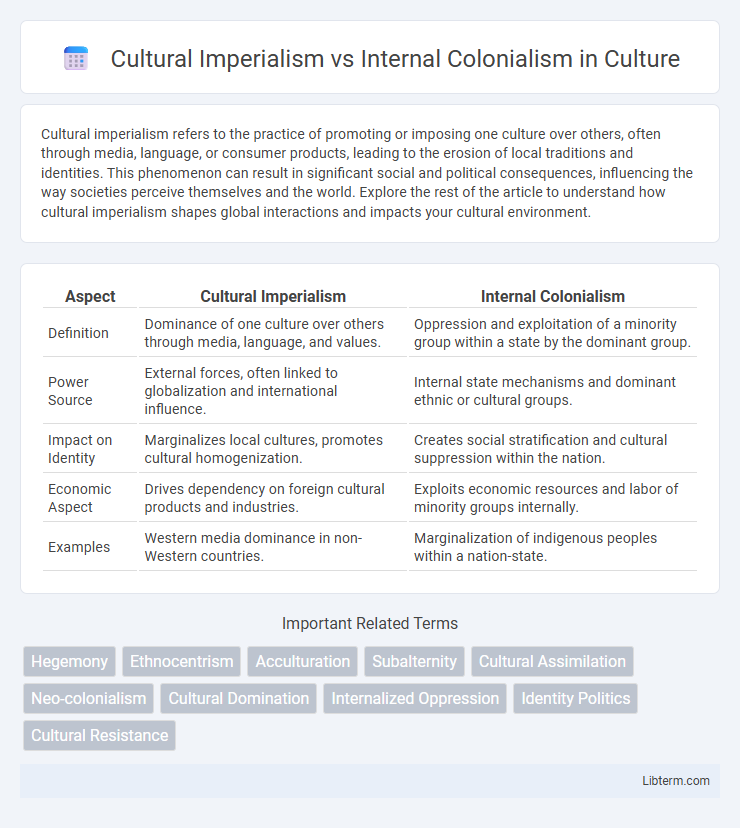Cultural imperialism refers to the practice of promoting or imposing one culture over others, often through media, language, or consumer products, leading to the erosion of local traditions and identities. This phenomenon can result in significant social and political consequences, influencing the way societies perceive themselves and the world. Explore the rest of the article to understand how cultural imperialism shapes global interactions and impacts your cultural environment.
Table of Comparison
| Aspect | Cultural Imperialism | Internal Colonialism |
|---|---|---|
| Definition | Dominance of one culture over others through media, language, and values. | Oppression and exploitation of a minority group within a state by the dominant group. |
| Power Source | External forces, often linked to globalization and international influence. | Internal state mechanisms and dominant ethnic or cultural groups. |
| Impact on Identity | Marginalizes local cultures, promotes cultural homogenization. | Creates social stratification and cultural suppression within the nation. |
| Economic Aspect | Drives dependency on foreign cultural products and industries. | Exploits economic resources and labor of minority groups internally. |
| Examples | Western media dominance in non-Western countries. | Marginalization of indigenous peoples within a nation-state. |
Defining Cultural Imperialism: Core Concepts
Cultural imperialism refers to the dominance of one culture over others, often through the imposition of values, beliefs, and practices that marginalize indigenous traditions and identities. This process typically involves the overwhelming presence of media, language, and consumer products from a powerful society, reshaping local cultures and social norms. Core concepts include cultural homogenization, hegemonic influence, and the erosion of cultural diversity driven by economic and political dominance.
Understanding Internal Colonialism: Key Features
Internal colonialism refers to the systematic oppression and exploitation of minority groups within a nation's borders, characterized by uneven economic development and political marginalization. Key features include centralized control by a dominant group, cultural domination, and restricted access to resources and opportunities for the subordinated population. This concept highlights structural inequalities embedded in national systems, distinguishing it from cultural imperialism's external influence.
Historical Origins of Cultural Imperialism
Cultural imperialism originated during the 19th and early 20th centuries as European powers expanded their empires, imposing their language, religion, and values on colonized societies to assert dominance and control. This concept contrasts with internal colonialism, which refers to the domination and marginalization of minority groups within a single nation-state. The historical roots of cultural imperialism are deeply tied to the colonial era's mission civilisatrice and the global spread of Western capitalist ideologies through media, education, and cultural institutions.
Roots and Evolution of Internal Colonialism
Internal colonialism emerged from historical patterns of economic and political domination within a nation, where dominant groups exploit minority regions through resource extraction and cultural suppression. Its roots lie in unequal power dynamics that reproduce structural inequalities and marginalize indigenous or minority populations, often evolving alongside state centralization and capitalist expansion. Over time, internal colonialism has manifested in policies of forced assimilation, segregation, and economic dependency, distinguishing it from external cultural imperialism by operating within national boundaries.
Mechanisms of Domination: External vs Internal Control
Cultural imperialism operates through external control mechanisms such as media dominance, language imposition, and educational system restructuring to influence and reshape the cultural identity of a dominated society. Internal colonialism, however, involves domestic control where a dominant group exploits peripheral regions or minority populations by controlling local economies, political structures, and social institutions to maintain unequal power relations within the same state. Both mechanisms sustain domination, but cultural imperialism relies on external cultural dissemination, while internal colonialism enforces control via internal structural inequalities.
Cultural Assimilation and Identity Erosion
Cultural imperialism enforces dominant cultural norms through imposed media, language, and educational systems, leading to cultural assimilation and identity erosion among marginalized populations. Internal colonialism occurs within a nation's borders, where dominant groups exploit and suppress minority cultures, causing the gradual loss of indigenous traditions and social identities. Both processes undermine cultural diversity by privileging hegemonic values and practices, resulting in the homogenization of cultural identities.
Economic and Political Impacts: Comparative Analysis
Cultural imperialism imposes dominant cultural values that reshape economic structures by prioritizing foreign markets and diminishing local industries, while internal colonialism exploits marginalized internal regions for resource extraction, reinforcing political domination and economic disparities within a nation. Economically, cultural imperialism fosters dependency on imported goods and transnational corporations, whereas internal colonialism concentrates wealth and power in central regions at the expense of peripheral areas. Politically, cultural imperialism influences governance through external cultural norms and policies, contrasting with internal colonialism's direct control over subjugated groups via state mechanisms and institutionalized inequality.
Resistance and Response: Communities Fight Back
Communities resisting cultural imperialism employ strategies such as reclaiming indigenous languages, preserving traditional rituals, and promoting local art forms to counteract homogenizing influences. In cases of internal colonialism, marginalized groups organize grassroots movements, seek legal reforms, and establish autonomous institutions to challenge systemic inequalities imposed by dominant powers. These acts of cultural resilience and political mobilization serve as powerful responses that affirm identity and demand justice amid external impositions.
Case Studies: Global Examples of Both Phenomena
Cultural imperialism manifests in global examples such as the widespread influence of American media, which shapes cultural norms and consumer behavior in countries across Asia, Latin America, and Africa, often overshadowing local traditions and identities. Internal colonialism is exemplified by the treatment of indigenous populations in countries like Canada and Australia, where systemic marginalization and economic exploitation occur within national borders, preserving dominant cultural and political control. Both phenomena reveal patterns of power imbalance, cultural dominance, and resistance that shape social dynamics on regional and global scales.
Toward Decolonization: Strategies for Cultural Empowerment
Cultural imperialism imposes dominant cultural values that marginalize indigenous identities, while internal colonialism enforces economic and political subjugation within a state. Strategies for cultural empowerment center on reclaiming indigenous languages, revitalizing traditional practices, and promoting self-representation through media and education. Empowering local communities through policies that support cultural sovereignty fosters decolonization and challenges systemic dominance.
Cultural Imperialism Infographic

 libterm.com
libterm.com